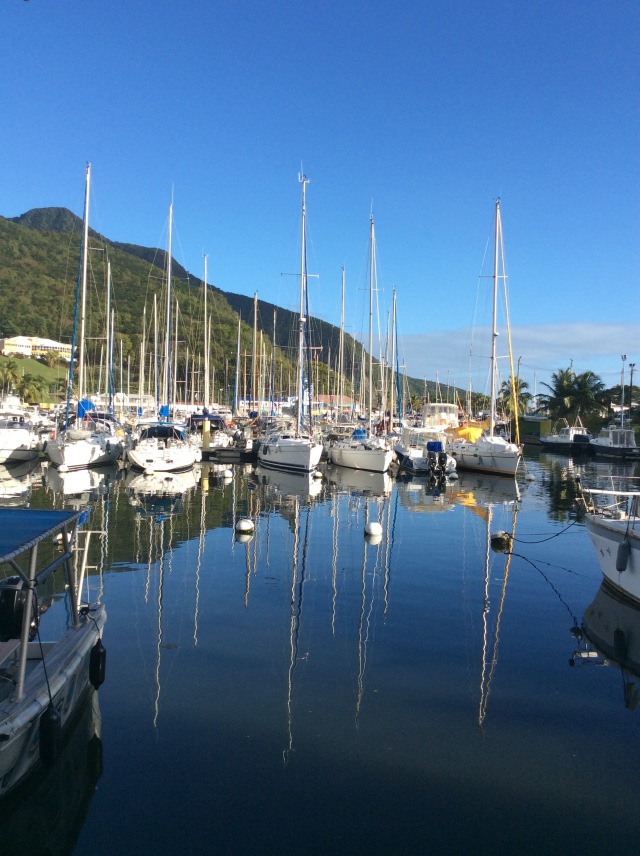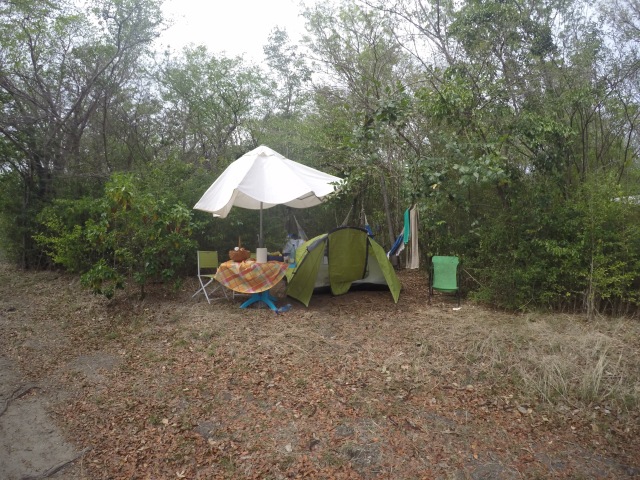
The clouds have moved out of the anchorage, but there are brief moments of clouds. The wind has also picked up. It’s too windy to head out for a swim so we decide to go ashore for a hike.

“Wait!” I say, totally surprised watching a nearby sailboat as they try to anchor. “Why is the genoa sail going out as they’re trying to anchor?” (Not a likely scenario, as sails are usually dropped or furled before making anchor.) But, sure enough we watch as the sail is releasing on its own and flapping downwind. As we watch from our dinghy we see there is only one person on deck (he was letting out the anchor) and from our vantage point in the dinghy, less than 100 yds away, we can see the confused look on his face (like “what the heck is happening?”) as he quickly brings the anchor back up. He then points to the furler line that has snapped, showing the captain at the wheel. They switch positions as the captain goes forward to try and figure out why it broke. The genoa is a big headsail, especially on this 47 ft boat and it is now snapping wildly in the wind. The sheets tied at the clew end, are snapping wildly and bound to crack someone violently that gets close, so the captain stays as low as he can going forward.
(Ok, here is where there are no pictures, camera crew was too busy…..use your imagination 🙂
The second mate is yelling something to the captain about where to go…It is then Mike and I realize that there is only one experienced sailor aboard and they need whatever assistance they can get. Trying to get this thing under control in an anchorage full of boats isn’t going to be easy. I turn to Mike and ask if he wants to try to board them. The boat is motoring slowly out of the anchorage, the only place to go, but there are scattered reefs at the entrance that must be avoided. I take over the control of the dinghy and we inch closer and closer to the sailboat, heading for the transom, the only footing that is plausible. I ease the dinghy in the shallow wake trying to match the speed of the sailboat, without going too fast to bump us off. We have to duck our heads to avoid injury as their dinghy is still hanging secure from the davits. I get Mike closer and for a split second just close enough for him to get a foot on their boat and a hand on a secure railing. I let off on the dinghy motor and float away from them. He takes over the wheel and I instantly see a look of relief on the second mate’s face. I also see a woman and 2 children aboard and they still have very concerned expressions. I hang back and watch as they motor slowly out of the anchorage, avoiding Horseshoe Reef to the north and Petite Rameau to the west.


Aboard the sailboat, the captain is forward and trying fervently to rewind the line around the furler drum. This will allow him to then pull it out thus rolling in the sail. Given a bit of time, which always seems so desperate with mechanical malfunctions, the issue is resolved. The sailboat returns to the beautiful island reef fringed by the turquoise reef to finally anchor for the afternoon.


Mike and I on Lost Loon had been at anchor for a day before this scenario took place. We did make it that afternoon to the top of Petit Batteau for a striking view of Horseshoe Reef anchorage. We walked back to the dinghy landing and sat for a while taking in the white sand, soft breeze and waving palms. Realizing as we had so many times on this trip how fortunate we are to see this part of the world from this vantage point.

Tobago Cays is a small group of islands and reefs located just 5 nautical miles south of Canoun, our last anchorage. We had made the trip in a short hour the previous day. We found an abundance of turtles just under the boat and snorkeled on a small part of the reef. The best snorkeling was at a break in the reef, called dinghy pass.

We awoke early on another warm bright morning the day we were to leave for more of the Grenadine islands. We could see the snorkeling grounds past the boats in the anchorage. We made sure there were no early morning divers already occupying the area, leaving us a place to secure the dinghy. We postponed our coffee ritual, grabbed our gear and after negotiating some shallow water tied the dinghy to the dedicated dive buoy in 15 ft of water at the pass. The water coming in the pass had a bit of a swell to it, but once we were in the water we floated most effortlessly. We were snorkeling in beautiful gin-clear (love that term…why not vodka-clear, really?) water with an abundance of fish species by 0800! Aside from a scuba mask that now wanted to fog up on the right, causing me to have to stop and remove to clear it we enjoyed a great early morning swim. We came across a huge barracuda and a few small rays as well as numerous reef fishes. Parrots, angelfish, huge schools of the tiniest purple fish we have ever seen, puffers, and even some squirrel fish with their big red eyes peering out for dangers of the deep were on the move that morning. There were staghorn coral, huge vase-like coral and purple fans everywhere waving to us in the surge. It was a great way to start the day.

We had plans to leave here for the island of Mayreau. We headed out the northern channel of the Tobago Cays staying north of Mayreau clearing the shallow reefs we made our approach past the idyllic beach anchorage of Salt Whistle Bay and down the western or leeward side of the island and Saline Bay.














